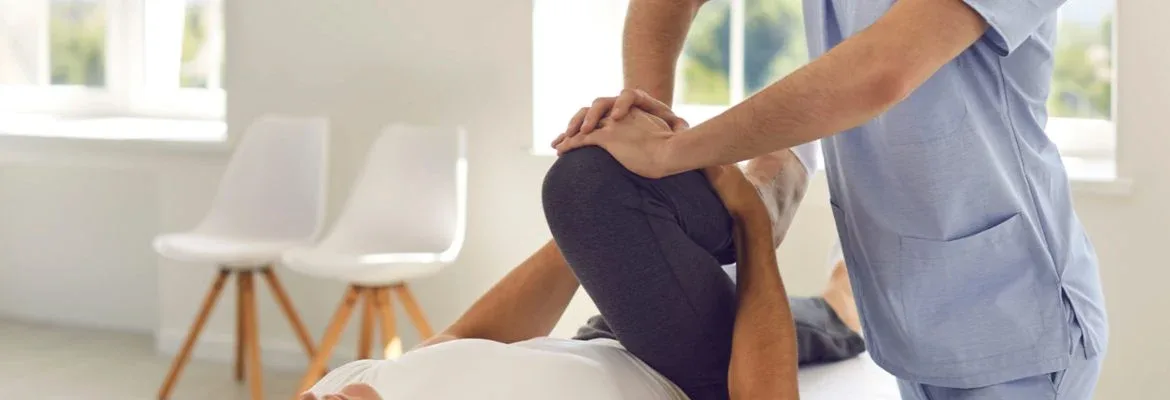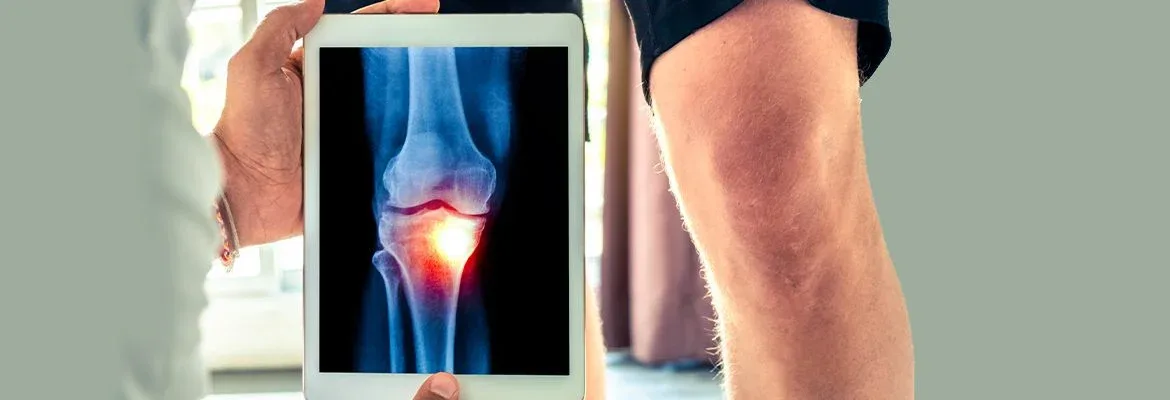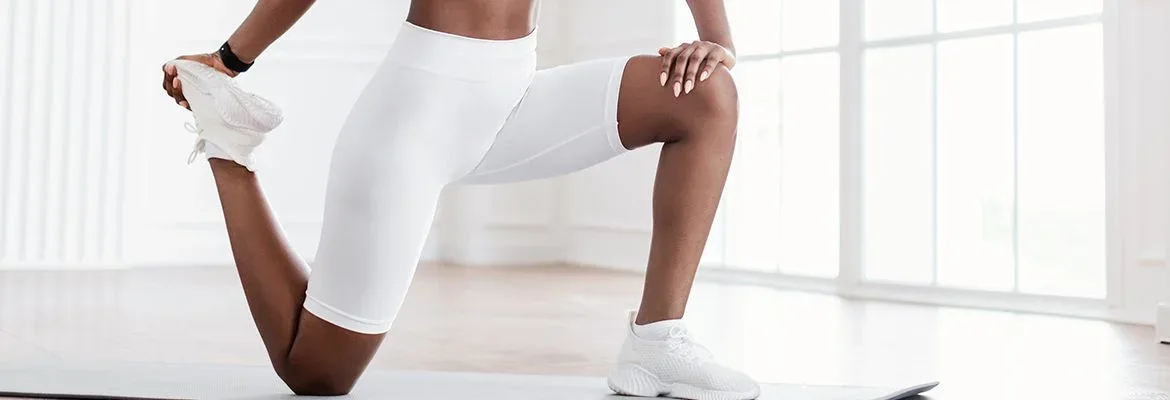Medial knee pain is a common orthopedic condition affecting the knee joint’s inner aspect. Several factors, including overuse, acute injury, and rheumatoid arthritis, can cause it. Medial knee pain can limit daily activities and cause functional limitations. Treatment options for medial knee pain include nonoperative treatments such as physical therapy, exercise programs, and surgical intervention for more severe cases. Understanding the causes and treatment options for medial knee pain is crucial for managing and preventing further injury.
I. Explanation of medial knee pain exercise and treatment

medial knee pain
Medial knee pain refers to pain experienced on the inner side of affected leg at the knee joint. Causes of medial knee pain include injuries to the medial collateral ligament, medial meniscus tears, and medial knee osteoarthritis.
Medial knee pain treatment depends on the underlying cause and severity of the condition. Nonoperative therapies such as rest, ice, compression, and elevation may reduce pain and swelling. Physical therapy may also be recommended to address functional limitations and improve range of motion. Strengthening exercises for the quadriceps and thigh muscles can help support the knee joint and prevent further injury.
In some cases, knee braces may provide additional support and stability. However, surgical intervention may be necessary if conservative treatment methods are ineffective.
Before beginning any exercise program to treat medial knee pain, seeking advice from a medical professional is crucial. Collaborating with a physical therapist is recommended to guarantee that exercises are executed correctly and not result in additional injuries. Range of motion knee strengthening exercises, foam rolling, and hip abduction exercises may be recommended to improve function and reduce pain in the knee joint. Gradual onset of physical activity and use of ankle weights and elastic bands may also be beneficial.
II. Diagnosis of Medial Knee Pain

medial knee pain
Diagnosing medial knee pain typically involves a physical examination and medical history review by a healthcare professional. In addition, they might request imaging tests like X-rays or MRI scans to assess the knee joint and surrounding areas more thoroughly. In addition, they might request imaging tests like X-rays or MRI scans to assess the knee joint and surrounding areas more thoroughly. The healthcare professional will assess the range of motion, stability, and strength of the knee and surrounding muscles. They may also perform specific tests to check for MCL or other ligament injuries. Accurate diagnosis is important to determine each case’s most appropriate treatment plan.
· Explanation of how medial knee pain is diagnosed
Medial knee pain is typically diagnosed through medical history, physical examination, and imaging tests. A thorough medical history is taken to identify the patient’s symptoms and their possible causes by a physician or physical therapist. The examination will then involve the following:
- Assessing the knee joint’s range of motion.
- Palpating the area for any points of tenderness or swelling.
- Observing the patient’s gait while walking.
X-rays, MRIs, and CT scans, all examples of imaging testing may also be ordered to provide a more detailed view of the knee joint’s structures and any potential irregularities. Based on these assessments, a diagnosis of medial knee pain may be made, and an appropriate treatment plan can be developed.
III. Treatment Options for Medial Knee Pain

There are several nonoperative treatments available for patients with medial knee pain. These options include:
- Physical Therapy: Physical therapists can work with patients to develop an exercise program to reduce pain and improve range of motion. Strengthening exercises, such as those targeting the quadriceps muscles, can help improve function and reduce symptoms.
- Knee Braces: Depending on the cause of medial knee pain, knee braces may be recommended. These can help stabilize the joint and reduce stress on the medial collateral ligament.
- Weight Loss: If a patient is overweight, by loose some weight, pain in the joints can be reduced.
- Medication: Over-the-counter pain medication, such as ibuprofen or acetaminophen, can help manage pain and inflammation.
- Injections: Corticosteroid injections into the knee joint can help reduce inflammation and pain. Hyaluronic acid injections may also be used to help lubricate the joint.
Most patients with medial knee pain can be managed with nonoperative treatments. It is always crucial to get medical advice and guidance when experiencing acute knee pain or functional limitations in daily activities.
· Non-Surgical Treatment Options
Medial knee pain can be treated without surgery through various nonoperative options. These include physical therapy, knee braces, weight loss, medication, and injections. These non-surgical treatments can help improve function and relieve symptoms for patients with medial knee pain.
· Rest, ice, compression, and elevation (RICE)
Medial knee discomfort is typically treated with the RICE method (rest, ice, compression, and elevation).
Rest allows the injured area to heal by reducing the stress and strain placed on it. Ice reduces inflammation and swelling by narrowing the blood vessels and slowing down blood flow to the area. Compression with an elastic bandage or brace can also help reduce swelling and support the injured leg and area.
Elevation also helps reduce swelling by allowing fluid to flow away from the injured area. Keeping the affected area above the heart level also helps prevent additional swelling.
·Physical therapy exercises
Physical therapy exercises are a crucial part of treating medial knee pain. These exercises can improve the range of motion, strengthen thigh muscles like the quadriceps, and help maintain functional limitations. Physical therapists can guide patients through a customized exercise program for their specific needs. Some exercises include hip abduction, knee flexion, and foam roller techniques. Gradual onset exercises with ankle weights and elastic bands can maximize results. Avoid making the injury worse by starting an activity program without first consulting a doctor.
· Use of knee braces
Knee supports are commonly used to treat knee injuries, including medial knee pain. These braces stabilize the knee joint, improving its function and preventing further damage.
Several knee braces are available, including prophylactic braces for injury prevention, functional braces for support during daily activities, and rehabilitative braces for use during physical therapy.
Knee braces work by exerting pressure on the knee joint, helping to align and stabilize the soft tissues and ligaments. They can also help to distribute weight more evenly across the joint, reducing stress on the affected knee area.
Certain knee braces, like those with hinges, can also help improve the mobility range and control the external knee adduction moment, contributing to medial knee pain.
· Medication
Medication is a treatment option for various conditions, including medial knee pain. However, seeking medical advice and following proper dosage instructions is important when taking medication. Nonsteroidal anti-inflammatory drugs (NSAIDs) can help reduce inflammation and relieve pain. Additionally, corticosteroid injections may be used for acute knee pain and inflammation. It is to note that medication should not be the only treatment used for knee pain and should be combined with other conservative treatments and exercise programs for optimal results. Discussing all options with a healthcare professional before starting any medication regimen is recommended.
· Surgical Treatment Options
Surgical treatment options are available for individuals who have exhausted nonoperative treatments for medial knee pain. Some common surgical interventions for medial knee pain include arthroscopy, osteotomy, and knee replacement surgery.
Those who have tried and failed nonsurgical methods of treating medial knee discomfort have surgical choices available to them. Surgical procedures like arthroscopy, osteotomy, and knee replacement are frequently used to treat medial knee pain.
To determine and treat injuries to the knee, such as a torn meniscus, loose cartilage, or damaged ligaments, arthroscopy makes use of a small camera implanted into the joint. Osteotomy is performed on younger, more active patients to straighten the tibia or femur and relieve strain on the medial knee joint. If alternative therapies have failed to alleviate the pain of severe osteoarthritis in the knee, a total knee arthroplasty may be considered.
The best course of treatment can only be determined in conjunction with a trained medical professional. Non-surgical methods, including as physical therapy and dietary and behavioral changes, are often tried before resorting to surgery.
· Knee arthroscopy
Arthroscopy of the knee is a non-invasive method of evaluating and fixing knee issues. A tiny camera is placed within the knee joint through a tiny incision so the surgeon may examine the area and pinpoint the source of any pain. Arthroscopy can address various issues, including torn ligaments, damaged cartilage, and loose bone or tissue fragments. As a minimally invasive procedure, knee arthroscopy typically requires less recovery and has fewer complications than traditional open knee surgery.
· Partial or total knee replacement
A partial knee straight or total knee replacement is surgery in which the damaged or worn out knee joint is replaced by an artificial implant. People with severe knee pain, stiffness, and mobility difficulties that do not improve with non-surgical therapy often receive recommendations for this operation.
A damaged piece of the knee joint is replaced during a partial knee replacement. A total knee replacement, on the other hand, entails substituting an artificial implant for the entire knee joint.
Knee replacement patients can need several weeks or months to fully recover. Regaining knee strength, flexibility, and range of motion through physical therapy is commonly suggested.
Although they are uncommon, knee replacement surgery risks include stiffness, pain, and infection. It’s crucial to contact your doctor immediately if you experience any unexpected symptoms after surgery.
IV. Inner Knee Pain Exercise Options

medial knee pain
Medial knee pain is a common problem experienced by many people, especially athletes and older individuals. Fortunately, several exercises can help relieve this type of knee pain.
One effective exercise is the straight leg raise. This exercise helps strengthen the quadriceps muscles, which can help take some pressure off the medial knee. Another good exercise is the side leg raise. This exercise targets the hip abductors, a thigh muscle which also stabilizes the knee joint.
Foam rolling is another effective technique that can help relieve medial knee pain. This involves using a foam roller to massage and stretch the thigh muscles, including the IT band. This can help relieve tightness and tension, contributing to knee pain.
Physical therapy can also be useful for those suffering from medial knee pain.
In severe cases, medial knee discomfort may require surgical intervention. However, nonoperative treatments including exercise and physical therapy can provide relief for the vast majority of patients. If you have sudden, severe knee pain or any other signs that could be caused by a knee injury, you should visit a doctor very away.
· Overview of exercises that can help alleviate medial knee pain
If you’re dealing with medial knee pain, some exercises can help alleviate your discomfort. Strengthening your quadriceps muscles and hip abductors can take pressure off your knee joint. Straight leg raises, and side leg raises are both effective exercises that target these muscles. Foam rolling can also be helpful by stretching and massaging your thigh muscles, including the IT band. Working with a physical therapist can provide tailored exercises, stretches, and other techniques to improve your range of motion and reduce pain. Always get your doctor’s approval before starting any new fitness routine.
· Explanation of how each exercise helps relieve discomfort
When relieving medial knee pain, exercise can be an effective tool to relieve knee pain. But what specific exercises can help alleviate the discomfort? Let’s take a closer look.
Firstly, strengthening the quadriceps muscles can help alleviate pain in the medial knee. Exercises like squats, lunges, and leg presses can target these muscles and increase their strength, which can help stabilize the joint and reduce discomfort.
Another exercise that can help relieve medial knee pain is hip abduction. This involves lying on your side and lifting one leg upwards, away from the upper body. This exercise can help strengthen the muscles that support the knee joint, which can, in turn, reduce pain and improve the mobility range.
Foam rolling can also help relieve stiffness and discomfort in the medial knee. By targeting the muscles around the knee, such as the thigh muscles and IT band, foam rolling can help reduce tension and improve flexibility in sore knee, alleviating pain.
In addition to these exercises, stretching can also be beneficial for reducing medial knee pain. Stretches targeting the hamstrings, calf muscles, and hip flexors can help improve flexibility and reduce stress on the knee joint. Keep in mind that some exercises may not be appropriate for people with medial knee pain.
In summary, exercises that target the quadriceps muscles, hip abduction, foam rolling, and stretching can all assist in relieving discomfort in the medial knee. By incorporating these exercises into a comprehensive treatment plan, individuals experiencing medial knee pain can improve their function and reduce discomfort.
· Some physical therapy or at-home exercise examples
· Straight Leg Raises
This exercise targets the quadriceps muscles, which are important for knee stability. Place one straight leg above the other and lie on your rear end. Lift the straight leg to the height of the bent knee and hold for a few seconds before slowly lowering the leg straight before it back down. Repeat for several reps before switching legs.
· Hamstring Curls
Hamstring curls help to strengthen the muscles located at the back of the thigh, which can help to support the knee. Lie on a bench or exercise ball with your legs hanging off the edge. Bend your knees gradually so that your heels are touching your buttocks. For a few seconds, maintain this position before releasing. Repeat for several reps.
· Wall Squats
Wall squats can help to strengthen the quadriceps and gluteal muscles, which can help to support the knee joint. Stand with your back against a wall and your feet shoulder-width apart. Slowly lower yourself into a squat position, keeping your back against the wall. Hold for a few seconds before slowly standing back up.
· Step-Ups
Step-ups can help to strengthen the quadriceps, gluteal and calf muscles, which can help to support the knee joint. Stand in front of a step or bench with one foot on top. Step up onto the court, lifting your the other leg or foot as well. Step back down and repeat for several reps before switching legs.
· Leg Press
The leg press machine can help to strengthen the quadriceps, gluteal and calf muscles, which can help to support the knee joint. Sit on the device with one leg bent, your feet on the platform and your knees bent. Push the platform away from you, straightening your legs. Slowly bend your knees and lower the platform back down. Repeat for several reps.
V. FAQ
Q: What is medial knee pain?
A: Medial knee pain is felt inside knee pain, on the knee’s inside (medial aspect). Various factors, including injury, overuse, or degeneration, can cause it.
Q: What are some common causes of medial knee pain?
A: Common causes of medial knee pain include medial collateral ligament injury, medial knee osteoarthritis, and patellar subluxation.
Q: What are some treatment options for medial knee pain?
A: Nonoperative treatments such as physical therapy and exercise programs can help alleviate medial knee pain.
Q: What exercises can help alleviate medial knee pain?
A: Straight leg raises, quad sets, wall slides, clamshells, and hamstring curls are all exercises that can help strengthen muscles and improve the range of motion in the knee.
· Can medial knee pain with flexion be prevented?
Regular exercise routines that target strengthening of the thigh and limb muscles can prevent joint knee pain with flexion. Additionally, avoiding direct blows to the medial knee, using proper form during physical activities, and wearing knee braces for extra support can also help prevent medial knee pain with flexion.
· When should I seek medical attention for medial knee pain?
Medial knee pain can occur due to injury, arthritis, or overuse. It’s important to seek medical attention if the pain persists over a few days or is severe. If the pain is accompanied by swelling, redness, or difficulty moving the knee, it’s also advisable to consult a doctor. Additionally, if the pain affects your daily activities or you are experiencing functional limitations, it’s best to seek medical advice. Early medical intervention can help diagnose the underlying cause and provide appropriate treatment, thereby preventing further damage to the knee.
· Can I still exercise with medial knee pain?
If you’re experiencing medial knee pain, seeking medical advice before continuing with any exercise program is important. In some cases, exercising with medial knee pain may worsen the condition or cause further injury.
However, with proper guidance and supervision, certain exercises can help alleviate symptoms and improve the range of motion in the knee. Gentle movements, such as hip abduction and knee flexion, can effectively strengthen the thigh muscles and reduce strain on the knee.
VI. Conclusion
In conclusion, medial knee pain can greatly impact daily activities and hinder range of motion. Nonoperative treatments such as exercise programs, physical therapy, and knee braces reduce pain and improve functional limitations. Surgical intervention may be necessary in acute injury or severe knee osteoarthritis cases. It is important to seek medical advice and properly diagnose the cause of medial knee pain before beginning any treatment plan. Regular physical activity, strengthening thigh and limb muscles, and incorporating foam rolling and hip abduction exercises can help prevent medial knee injuries. Remember that some knee injuries, such as a patellar subluxation or posterolateral knee injury, may require different treatments than medial knee pain.
